 Front Range, Eastern Slope, Rocky Mountains
Front Range, Eastern Slope, Rocky Mountains

Tom Schweich
 Front Range, Eastern Slope, Rocky Mountains
Front Range, Eastern Slope, Rocky Mountains
| Checklist Flora of Native and Naturalized Vascular Plants of Golden and Vicinity, Jefferson County, Colorado (Continued) |

|
Tom Schweich |

Topics in this Article: Introduction Geography History of Botanic Exploration and Publication Useful Publications Methods Results Discussion - Native Plants Discussion - Non-Native Plants Conclusion Acknowledgements Literature Cited Appendices |
Golden, Colorado sits in a valley formed by erosion along the Golden fault, the geotectonic boundary between the North American Cordillera and the Great Plains. Somewhat like Mono Lake, for which I have also prepared a checklist flora, it sits at a boundary, or perhaps ecotone. Things are always more interesting at the boundaries. I started this project when I realized no such list had been prepared for my newly adopted city. I hope you find this checklist flora helpful. Please write to me if you have questions or comments. | ||||||||||||||||||||||||||||||||
|
|
History of Botanic Exploration and Publication | ||||||||||||||||||||||||||||||||
|
Literature Cited:
Other articles:
Locations: Fort Mandan Historical Site. Missouri River. Yellowstone River. |
Several early expeditions contributed botanic knowledge that applies to Colorado without actually entering Colorado. Chief among them is the Lewis & Clark Corps of Discovery Expedition of 1804-1806. Part of their route was along the Missouri River, and many plants found there are also found in Colorado. Thomas Nuttall ascended the Missouri River from St. Louis in 1811, loosely accompanied by John Bradbury. He traveled at least as far as Fort Mandan, and possibly to the junction of the Missouri and Yellowstone Rivers. Nuttall (1813) published a short list of plants available for sale in England resulting from his travels. This list of 89 plants included seven that are found in Golden s.l.1 The collections of Lewis & Clark, along with some collections by Nuttall and Bradbury, were published by Frederick Pursh (1814) in his Flora Americae Septentrionalis. We have 31 names in the Golden s.l. flora that are at least in part attributed to Pursh (1814). At least eighteen, and possibly twenty, taxa in the Golden s.l. flora were described from Lewis & Clark collections.2 Pursh (1814) published seven taxa collected by Bradbury in 1811 along the Missouri River that are found in Golden s.l.3 Pursh (1814) also published eleven taxa that he attributed to Nuttall collections along the Missouri River in 1811, and are found in Golden s.l.4 Far more comprehensive, Nuttall (1818) published his Genera of North American Plants. This epic work for its time described 834 genera that were fully described in English, as were numerous new species that Nuttall introduced. Finally, Nuttall's 1819 near-fatal expedition to Arkansas added more names to the Colorado flora, such as Aristida purpurea, Coreopsis tinctoria, and Physalis longifolia. | ||||||||||||||||||||||||||||||||
|
|
The Long Expedition to the Rocky Mountains 1819-1820The first scientific expedition to Colorado was the Stephen H. Long expedition of 1819-1820. Of course, at the time there was no “Colorado” and the area explored by the Long expedition was known as Missouri Territory. | ||||||||||||||||||||||||||||||||
| Major Stephen H. Long, an army engineer, promoted scientific exploration in the west to President James Monroe and Secretary of War John Calhoun. In 1818, he received authorization to form a scientific group and undertake an expedition. His scientific staff included Edwin James, M.D., a twenty-three year old Vermonter, as botanist. The expedition set out on June 6, 1820, from Engineer Cantonment on the Missouri River, about 5 miles below Council Bluffs. | |||||||||||||||||||||||||||||||||
|
Literature Cited:
Other articles:
Locations: Inspiration Point. |
| ||||||||||||||||||||||||||||||||
|
Literature Cited:
Other articles:
|
At some location on the 5th, James made two collections. One collection was identified by Torrey as Sium latifolium L. Roem. And Schult. Vi. P. 331. Tor. Fl. i. p. 311. Base of the Rocky Mountains. Is listed in Goodman and Lawson (1995) as Sium suave Walter Water Parsnip. Ackerfield (2015) says this taxon does not occur in Jefferson County, and SEINet supports this contention, save for one 1977 collection at a Main Reservoir near Mississipi and Kipling in Lakewood.
Torrey lists Stipa barbata Michx. fl. i. p. 53. as being found on the sources of the Platte and Canadian. He then goes on to observe "… grows with Cenchrus echinatus, and like that plant is very troublesome ; the bearded awns adhering to and penetrating the dress." Goodman and Lawson (1995, p. 210) state that both Stipa barbata and S. juncea, as used by James, are synonyms for Hesperostipa comata (Trin. & Rupr.) Barkworth. | ||||||||||||||||||||||||||||||||
|
Other articles:
Locations:
Platte Canyon.
Roxborough Park.
Sheep Mountain.
|
On July 6th, they moved to the mouth of Platte Canyon, and explored in the Roxborough Park area. The next day James and several others struggled up the north bank of the South Platte, reaching the southeast slopes of Sheep Mountain.
The southeast slopes of Sheep Mountain are most likely locations for many of James' new species. In particular: Eriogonum umbellatum Torr. “Sulphur Flower,” Physocarpus monogynus (Torrey) Coulter “Mountain Ninebark,” and Acer glabrum Torrey “Rocky Mountain Maple” were most likely collected on Sheep Mountain. James' collection of Cercocarpus montanus Raf. “Alder Leaf Mountain Mahogany” was probably made at the mouth of Platte Canyon. There are several other collections that may have been made in this area, but the time or location may be unclear, or in the case of Rubus deliciousus the material actually collected is unclear. | ||||||||||||||||||||||||||||||||
|
Literature Cited:
Other articles:
|
In 1823, the “Account of an Expedition from Pittsburgh to the Rocky Mountains performed in the years 1819, 1820, by order of the Hon. J. C. Calhoun, under the command of Major Stephen H. Long,” in two volumes, and edited by Edwin James was published. The botany of the expedition is not covered in detail in these volumes. There are only a few references or notes to plants collected or seen along the way. | ||||||||||||||||||||||||||||||||
|
Literature Cited:
|
John Torrey (1824a) “Description of some new or rare plants from the Rocky Mountains, collected in July, 1820, by Dr. E. James” describes some new plants from Pikes Peak slopes and summit. None of the plants were collected in Jefferson County, Colorado. | ||||||||||||||||||||||||||||||||
|
Literature Cited:
|
John Torrey (1824b) “Description of some new grasses, collected by Dr. E. James, during the expedition of Major Long to the Rocky Mountains, in 1819-1820” contains no new grasses from Jefferson County, Colorado. | ||||||||||||||||||||||||||||||||
|
Literature Cited:
|
In 1825, James published a “Catalogue of Plants Collected During a Journey to and from the Rocky Mountains, During the Summer of 1820.” However, this account does not include any previously undescribed plants. | ||||||||||||||||||||||||||||||||
|
Literature Cited:
Other articles:
|
Finally, in 1828, Torrey's “Some account of a Collection of Plants made during a journey to and from the Rocky Mountains in the summer of 1820, by Edwin P. James, M. D. Assistant Surgeon U. S. Army.” some of the new taxa from Jefferson County. These collections were made on the southeast slopes of Sheep Mountain, above Waterton Canyon. Some of the new taxa were Acer glabrum Torr. “Rocky Mountain Maple,” Spiraea monogyna Torr. (=Physocarpus monogynus (Torr.) J. M. Coult.) “Mountain Nine-bark,” and Eriogonum umbellatum Torr. “Sulphur-flower Buckwheat” Torrey's caution got the best of him with his acceptance of Cercocarpus fothergilloides Kunth for what later became C. montanus Raf. While none of these plants were collected in Golden by the Long Expedition, there are all quite common here. | ||||||||||||||||||||||||||||||||
|
Other articles:
|
Tragia ramosa Torr. Branched Noseburn. | ||||||||||||||||||||||||||||||||
|
Literature Cited:
Other articles:
|
Rafinesque was pretty unhappy with Torrey being " ...so very cautious that he will not admit any improvement except after long delays and previous precedents …" which left him feeling "… compelled to rectify this omission by forming many new genera and species out of [Torrey's] plants, for my florula Oregonensis." Justifying his action by stating " …hesitation in science is often as injurous as haste. It is even better to have two names for an object than no name at all," Rafinesque published Cercocarpus montanus Raf. in “Twenty new genera of plants from the Oregon Mountains, &c.” | ||||||||||||||||||||||||||||||||
|
Literature Cited:
Other articles:
Locations: Mount Vernon Canyon. |
Thomas Nuttall on the Oregon Trail, 1834Two Townsendias are commonly collected in the Golden area: T. grandiflora and T. hookeri. Both were first collected in 1834 by Thomas Nuttall during his journey with the Wyeth expedition from St. Louis, Missouri, to Fort Vancouver, Oregon. Nuttall kept no journal during this trip, so his localities are always a bit of a mystery. Some location data can be derived from his published account and the label data on his specimens. “Plains of the Platte” is probably the most accurate location description for T. grandiflora, whereas "an alpine chain toward the sources of the Platte" is the most descriptive location for T. hookeri. Nuttall's determination of his collection was T. sericea Hook. T. sericea is an illegitimate name and a synonym of T. exscapa (Richardson) Porter.
| ||||||||||||||||||||||||||||||||
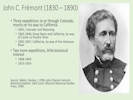 John C. Fremont expeditions through Colorado. John C. Fremont expeditions through Colorado.
|
John C. Fremont came through Colorado a couple of times. Three of his expeditions have some botanical interest.
| ||||||||||||||||||||||||||||||||
|
Locations:
Fort Saint Vrain.
|
On Fremont's first expedition through Colorado he came up the South Platte River to Fort Saint Vrain, then cut across our current US Highway 287 to Fort Laramie. He sent his plant collections to Dr. John Torrey without prior agreement. However, it worked out because Torrey and Gray were eager to receive plants from the west. Two collections we might recognize from Fremont's 1st expedition are Senecio spartioides Torr. & A. Gray and Penstemon strictus Benth. in DC. The former is certainly native to Golden s.l.. The latter is widespread in gardens, but unlikely to be native here. | ||||||||||||||||||||||||||||||||
|
Locations:
Cache La Poudre River.
Laramie River.
Schweich Hill.
|
In Fremont's 2nd expedition (1843-1844), he again came up the South Platte River, then turned south and traveled along the Front Range to the Arkansas River. This is probably his closest approach to Golden s.l.. After returning to Fort Saint Vrain, Fremont left Colorado by way of the Cache La Poudre River and then the Laramie River. Two collections that we might recognize from Fremont's 2nd expedition are Lithospermum multiflorum Torr. ex A. Gray and Penstemon secundiflorus Benth. in DC. L. multiflorum is usually found at a little higher elevation than Golden s.l., for example, at Ranson/Edwards Homestead Open Space. P. secundiflorus, on the other hand, is quite common in Golden, and has been collected on North and South Table Mountains, and on Schweich Hill. | ||||||||||||||||||||||||||||||||
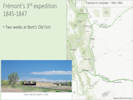 Fremont in Colorado, 1845-1847. Fremont in Colorado, 1845-1847.
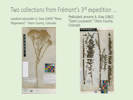 Two collections from Fremont's 3rd expedition. Two collections from Fremont's 3rd expedition.
|
In 1845, Fremont arrived at Bent's Old Fort by way of the Arkansas River. He spent two weeks there, before continuing up the Arkansas River, over Tennessee Pass, and down to the Colorado River. | ||||||||||||||||||||||||||||||||
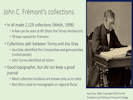 Summary of John C. Fremont's collections. Summary of John C. Fremont's collections.
|
In all, Fremont made 2,129 collections (Welsh, 1998), a few of which can be seen at NY (from the Torrey herbarium). Thirty-nine taxa are named for Fremont. The collections were split between Torrey and Asa Gray. Asa Gray identified the Compositae and gamopetalae (united petals). John Torrey identified all others. While Fremont was a good topographer, he did not keep a good journal. Most collection locations are known only as to state. Therefore they are not often cited in monographs or regional floras. | ||||||||||||||||||||||||||||||||
|
Literature Cited:
Other articles:
|
Charles C. Parry in upper Clear Creek, 1861Charles Christopher Parry (1823-1890) was trained as a doctor, and briefly maintained a practice in Iowa. His first botanical work was on the Mexican Boundary Survey (1849-1852). He came to Colorado in 1861 and botanized primarily on upper Clear Creek and the alpine ridges east of Middle Park. Otherwise, there is no detailed itinerary or location data available for his collections. One would assume he traveled through Golden, but we have no information to confirm that. Nearly all of Parry's 861 collections are at eastern herbaria: Academy of Natural Sciences of Drexel University (PH), Brown University Herbarium (BRU), Harvard University Herbaria (GH), New York Botanical Garden NY), and Yale University Herbarium (YU). | ||||||||||||||||||||||||||||||||
|
Literature Cited:
Other articles:
|
Parry, Hall, and Harbour, 1862Parry returned to Colorado in 1862, accompanied by Elihu Hall and J. P. Harbour. Hall was a surveyor Illinois, and Harbour may have been his cousin. They were probably more interested in collecting plants for sale, rather than the botany of the region. Because they traveled up Clear Creek, one would assume they passed through Golden, or perhaps Apex City and Mount Vernon. Regardless, the trio covered much of Douglas, Jefferson, and Park Counties before arriving at Manitou Springs. | ||||||||||||||||||||||||||||||||
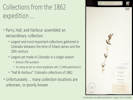 Charles C. Parry in Colorado in 1862. Charles C. Parry in Colorado in 1862.
|
Parry, Hall, and Harbour assembled an extraordinary collection on their 1862 expedition. At almost 700 collections, it is the largest and most important collection gathered in Colorado between the time of Edwin James and the 20th century. There were as many as ten or more duplicate sets. As Hall & Harbour left the expedition before Parry and began selling their collections, they became known as the “Hall & Harbour” Colorado collections of 1862. Unfortunately, many collection locations are unknown, or poorly known. Even though there is no evidence that Parry, Hall, and Harbour collected plants in Golden s.l., Apex City, or Mount Vernon, their collections in other parts of Colorado overlap those found in Golden by 114 names, about 23% of the native flora, or about 16% of the total Golden flora. | ||||||||||||||||||||||||||||||||
|
Powell returned to the Grand River in summer 1868 with a team of twenty men, mostly young students, ready to devote the next several months to science and discovery. Major Powell enlisted the help of the future Chief Botanist of the Department of Agriculture, Dr. George Vasey. Vasey and the traveling party were able to document 66 pages of flora and collect almost 700 plant specimens during the expedition. They sent the specimens to over seventy schools, colleges, and museums, including the Smithsonian U.S. National Herbarium. https://naturalhistory.si.edu/research/botany/about/historical-expeditions/j-w-powell-colorado-exploring-expedition-1868 | |||||||||||||||||||||||||||||||||
|
Literature Cited:
Other articles:
|
The First Collection Made in GoldenThe oldest collection from Golden with reliable data is E. L. Greene's collection of Oxytropis lambertii Pursh on May 1, 1870. Greene moved to Colorado in 1870. The location is given simply as “Golden.” This collection is at the Brown University Herbarium, on a voucher with a Hall & Harbour collection made in 1862. While O. lambertii was described by Pursh (1814), it is not a Lewis and Clark collection. Pursh described it from a collection by John Bradbury (1768-1823) on the Missouri River.
| ||||||||||||||||||||||||||||||||
|
Literature Cited:
|
There is another plant collection giving Golden as the location that carries an earlier date. It is a anonymous collection of Crataegus occidentalis Britton that gives "By streams near Golden" as the location. The collection date is reported as 1822 by NY, the holder of this voucher.
There is a problem with the collection date, though. Golden was not founded until 1859, when it was named for Thomas L. Golden, who arrived in then-Kansas Territory in 1858. The only collectors in the area near the 1822 date were the Major Stephen Long expedition of 1820. A collection from that expedition would have ended up in the Torrey Herbarium as this specimen did. There is a pencilled notation above "Rev. E. L. Greene" and perhaps that note would shed some light. It is also possible that the label was written and affixed many years after the collection was made. Examining the date hand-written on the label, it appears that it could 1872 rather than 1822. If the date were 1872 then the collector could have been C. C. Parry, E. L. Greene, or possibly someone else. Britton's (1900) description of C. occidentalis states that the types were “… collected by Prof. E. L. Greene, near Golden, Colo., 1873, along streams, in flower; on river-bank near the Forks of Dismal River, Hooke Co., Nebr., collected by Dr. P. A. Rydberg, July 11, 1893, in fruit.” This seems pretty conclusive, that the collection in question, was likely collected in 1872(3) and that the collector was probably E. L. Greene. Ackerfield (2015) treats Crataegus occidentalis Britton as a synonym of C. succulenta Schrad., whereas FNANM treats it as a synonym of C. macracantha Loddiges ex Loudon. | ||||||||||||||||||||||||||||||||
|
In 1871 and 1872, Hayden led expeditions to the Yellowstone area in Wyoming, bringing back geological data, maps, and collections, as well as the photographs that helped popularize the natural beauty of Yellowstone. However, in 1873, the heavy expenses of shipping supplies to an area with no railroad, in addition to the threat of hostile American Indians, led Hayden to shift his focus to Colorado instead. | |||||||||||||||||||||||||||||||||
|
John M. Coulter, who had accompanied Hayden’s expedition to Yellowstone in 1872, continued in his role as an expedition botanist in 1873. He was an assistant in the expedition, gathering plant specimens in the Park Range Mountains and nearby mountain streams. Coulter found several specimens near Clear Creek, a mountain stream tributary to the Arkansas River, including Britton’s skullcap (Scutellaria brittonii), which is a member of the mint family, and the Virginia strawberry Fragaria firma, now known as Fragaria virginiana, which he collected at over 8000 ft in elevation. Specimens found in the Park Range mountains include arctic brome (Bromus kalmii) found at Buffalo Peaks, and large mountain fleabane (Erigeron coulteri), a new species found at 10,000 feet in elevation at Weston’s Pass, to the north of Buffalo Peaks. | |||||||||||||||||||||||||||||||||
|
Literature Cited:
Other articles:
|
Instead of publishing his findings in the Annual Report of the expedition, as he had the year before, Coulter worked with Thomas C. Porter to incorporate them into the Synopsis of the Flora of Colorado, a compilation of descriptions of plants found on various exploring expeditions. They drew from collections and locations are given for Parry, Hall & Harbour, Brandegee, Greene, Porter, Coulter, and others. Names published by Torrey from James' (1820) collections are listed but not credited to James, nor are James' locations identified. The authors treat both Chrysothamnus and Ericameria as Bigelovia placing Linosyris in synonomy. In a footnote Chrysothamnus Nutt. is placed in synonomy with Bigelovia DC. Bigelovia graveolens (Nutt.) A. Gray is treated at the species level with no mention of B. nauseosa. | ||||||||||||||||||||||||||||||||
|
Literature Cited:
Other articles:
|
John M. Coulter (1885) Manual of the botany of the Rocky mountain region continues to use Bigelovia DC for Chrysothamnus and Ericameria, giving it a common name of “Rayless Golden-Rod”. Coulter also continued to accept B. graveolens with no recognition of B. nauseosa. | ||||||||||||||||||||||||||||||||
|
Literature Cited:
Other articles:
|
Per Axel Rydberg (1906) Flora of Colorado worked with collections from Colorado Agricultural College (now Colorado State University, Fort Collins) and those at New York Botanic Garden. Rydberg received financial support from the Colorado Department of Agriculture, and botanical assistance from N. L. Britton. Many of the collections Rydberg worked with were made by Charles S. Crandall, who was Professor of Botany beginning in 1889, and was assisted by J. H. Cowan. SEINet has about 6,000 collections by Crandall, many of which also bear Cowan's name. Rydberg accepted Eriocoma Nutt, and placed E. cuspidata Nutt. There. He used a common name of “Rabbit-brush” with genus Chrysothamus Nutt. | ||||||||||||||||||||||||||||||||
|
Literature Cited:
|
John M. Coulter & Aven Nelson (1909) New Manual of Botany of the Central Rocky Mountains was an update to Coulter's (1885) Manual. Our common rabbitbrush was placed in Chrysothamnus, which was given common names of “Rabbit Brush” and “Rayless of False Goldenrod.” C. graveolens (Nutt.) Greene was retained at the species rank, as was C. nauseosa (Pall.) Brit. | ||||||||||||||||||||||||||||||||
|
Literature Cited:
Other articles:
|
In the preface to Rydberg's (1917) Flora of the Rocky Mountains and adjacent plains, he doesn't explain why he wrote the flora, except to note: After more than twenty-five years of study of the flora of the Rocky Mountain region, and seventeen years after the first description was drawn for the book, this manual is now presented to the public.He does note that The publication of a second edition of Coulter's Manual in the form of “A New Manual of Botany of the Central Rocky Mountains,” by J. M. Coulter and Aven Nelson, in 1909, made the appearance of the contemplated flora less urgent, as the need was partly supplied, and the issuing of the manual was delayed. Rydberg acknowledges the assistance to Mr. George E. Osterhout, of Colorado. Rydberg (1917) gives no common name to Ericameria, but lists “Rabbit Brush” as a common name of Chrysothamnus. C. graveolens (Nutt.) Greene and C. nauseosus (Pursh) Britton and treated separately. | ||||||||||||||||||||||||||||||||
|
Literature Cited:
Other articles:
|
Rydberg's (1922) 2nd edition added 2 families, 17 genera, and 132 species, none of which appear to have affected Colorado. Rydberg does note that he received help of “ … Mr. G. E. Osterhout, Prof. E. Bethel, and Miss Hazel M. Schmoll, of Colorado … ” Title Flora of the Rocky Mountains and adjacent plains, Colorado, Utah, Wyoming, Idaho, Montana, Saskatchewan, Alberta, and the neighboring parts of Nebraska, South Dakota, and British Columbia https://www.biodiversitylibrary.org/bibliography/161373 | ||||||||||||||||||||||||||||||||
|
Literature Cited:
|
Harrington's Manual of the Plants of Colorado (1954) is occasionally helpful because it has more extensive descriptions of the taxa. Also, Harrington wrote a natural key rather than the artificial key in Weber & Wittmann (2012) and Ackerfield (2015). One problem is, though, that the progress of science has made some of Harrington's groups obsolete or moved some taxa from one group to another. | ||||||||||||||||||||||||||||||||
|
Literature Cited:
|
Ernest H. Brunquist (1888-1978) was curator of botany at the Denver Museim of Nature and Science from the late 1950s to the late 1970s. Brunquist (1966) prepared a local checklist flora of the Heritage Square area as part of the report on Excavations at Magic Mountain (Irwin-Williams and Irwin, 1966). | ||||||||||||||||||||||||||||||||
|
Literature Cited:
Locations: South Table Mountain. |
The Jefferson Sentinel in July, 1972 ran a long article about South Table Mountain describing its history and the need to save it as park land. | ||||||||||||||||||||||||||||||||
|
Literature Cited:
Locations: South Table Mountain. |
Georgina Brown's Book, The Shining Mountains, describes a grisly murder that took place on South Table Mountain. | ||||||||||||||||||||||||||||||||
|
Literature Cited:
Locations: North Table Mountain. |
The Colorado Chapter of the Nature Conservancy funded an ecological survey of North Table Mountain by Larry S. Zeise (1976) under the supervision of John W. Marr of the University of Colorado, Boulder, CO. | ||||||||||||||||||||||||||||||||
|
Literature Cited:
Other articles:
Locations: North Table Mountain. |
Paul Kilburn and Sally White (1992) published a short volume on the history and natural features of North Table Mountain. With permission of the authors, I have republished their volume on this website. | ||||||||||||||||||||||||||||||||
|
Literature Cited:
Locations: North Table Mountain. |
North Table Mountain was described in a report by the Colorado Natural Heritage Program as posessing a Biodiversity rank of B4 (Pague, et al., 1993). | ||||||||||||||||||||||||||||||||
|
Locations:
North Table Mountain.
South Table Mountain.
|
In 2001, a presentation by Dr. Robert Raynolds, Loraine Yeatts, and Dr. Kirk Johnson, was made at the American Mountaineering Center describing why the Table Mountains were important to preserve. | ||||||||||||||||||||||||||||||||
|
Literature Cited:
|
|||||||||||||||||||||||||||||||||
|
Literature Cited:
Locations: South Table Mountain. |
Maureen O'Shea-Stone published a vegetation survey report of the portion of South Table Mountain owned by the National Renewable Energy Laboratory (Plantae Consulting Services, 2002). | ||||||||||||||||||||||||||||||||
|
Literature Cited:
Other articles:
|
When I started this, Shaw's (2008) Grasses of Colorado was typically where I started with grasses. I will often then use Ackerfield (2015) or Weber & Wittmann (2012) to confirm a grass determination. Although, for a few collections, most recently one of Elymus lanceolatus, the most straight forward key was found in Wingate (1994) Illustrated Keys to Grasses of Colorado. And, finally, just to insert an element of heresy into the discussion, keying out a brome used in a revegetation project proved to be impossible until I turned to Baldwin, et al. (2012) Jepson Manual of the California Flora. However, recently Wingate's (2021) Colorado Grasses has become my first stop for Colorado grasses. | ||||||||||||||||||||||||||||||||
|
Literature Cited:
Locations: North Table Mountain. |
The Colorado Natural Heritage Program prepared a survey of critical biological resources for Jefferson County (Sovell, et al., 2012), in which North Table Mountain was upgraded to Biodiversity Rank B3. | ||||||||||||||||||||||||||||||||
|
Literature Cited:
|
Weber and Wittmann's Colorado Flora: Eastern Slope (2012, 4th edition) is a highly developed diagnostic manual. Colorado Flora began as a mimeographed Flora of Boulder County (Weber, 1949). It evolved into a Handbook of Plants of the Colorado Front Range in 1953. In 1967, it morphed into Rocky Mountain Flora. The fourth edition published in 1972. Ron Wittmann, a physicist, appeared in the 1970s, and together Weber & Wittmann published the first editions of Colorado Flora: Western Slope (1987) and Colorado Flora: Eastern Slope (1990). We are currently using the fourth edition of those two floras. Colorado Flora suffers somewhat from an unconventional use of names, though occasionally the authors were simply ahead of their time. However, with a little use, the synonomy with other floras becomes fairly clear. I typically use Weber & Wittmann (2012) to confirm a determination. Sometimes, though, a plant will key out easily in this manual when it has failed in another. There are several taxa that are not recognized by Weber & Wittmann (2012), but are in Ackerfield (2015). Chief among them are Oenothera biennis and Eriogonum arcuatum. Specimens of those taxa will key out to O. villosa and E. flavum, respectively. This has caused small problems for the author for plants collected on North Table Mountain and in the Deadman Gulch area. For example a specimen collected on North Table Mountain would be keyed out as E. flavum in 2014, when I first began collecting, but as E. arcuatum in 2016. I suspect that a similar dissonance will be found among herbarium vouchers. | ||||||||||||||||||||||||||||||||
|
Literature Cited:
|
Ackerfield's (2015) Flora of Colorado is, of course, the current best manual for Colorado. Its publication was a great step forward. Like when I used to write computer code, the first version was always serviceable, but each succeeding version was an enormous improvement, and we eagerly await the next edition of Flora of Colorado. | ||||||||||||||||||||||||||||||||
|
Literature Cited:
|
I have successfully used Wingate's (2017) Sedges of Colorado, and I am still learning my way around the book and sedges. The book is really well-illustrated, in the keys, in the species descriptions, and in the supplemental information. | ||||||||||||||||||||||||||||||||
|
Literature Cited:
Other articles:
|
The best grass book ever is Wingate (2021) Colorado Grasses with Illustrated Keys. | ||||||||||||||||||||||||||||||||
| Understanding urban flora … | |||||||||||||||||||||||||||||||||
|
| |||||||||||||||||||||||||||||||||
|
Literature Cited:
Other articles:
|
1There are seven taxa found in Golden s.l.that were first published in Nuttall (1813)
C:\Users\tomas\OneDrive\Documents\CoNPS 1D\Nuttall and Colorado\Historic_Collections.xlsx | ||||||||||||||||||||||||||||||||
|
Literature Cited:
Other articles:
|
2 There are at least eighteen, and possibly twenty, taxa in the Golden s.l. flora that were first published by Pursh (1814) from Lewis & Clark collections.
|